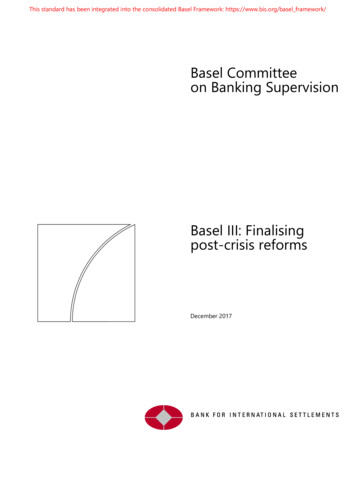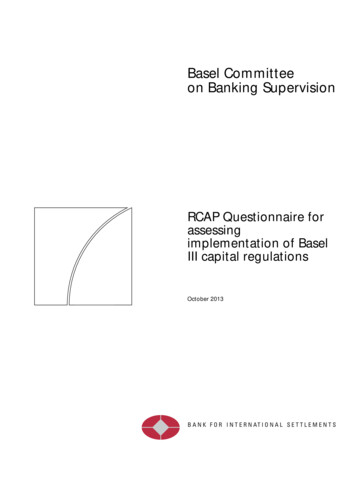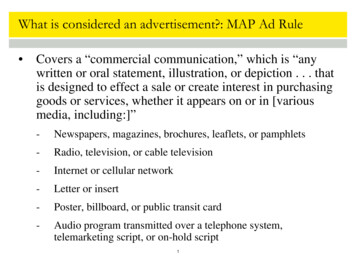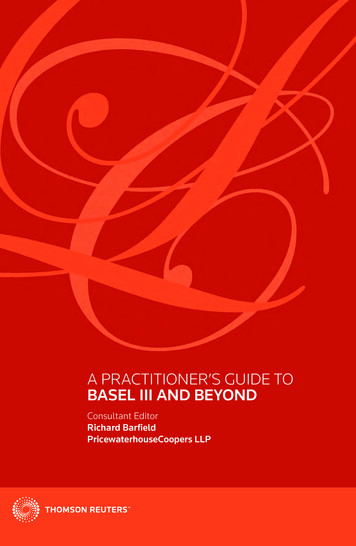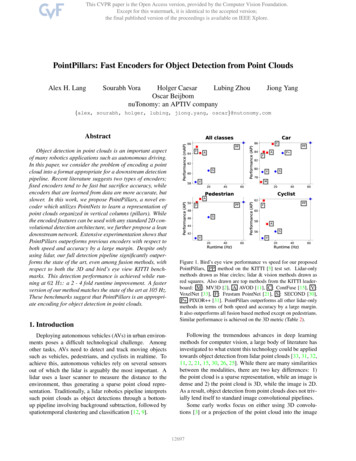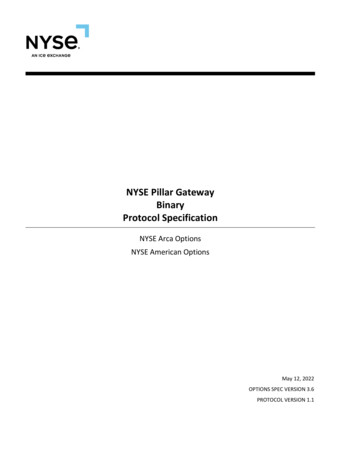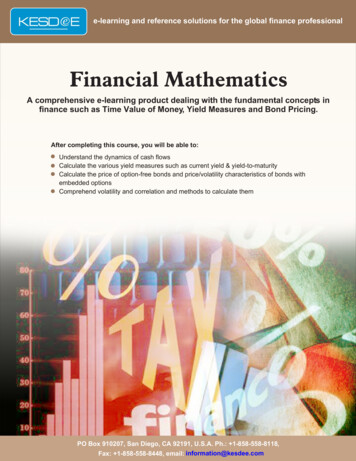
Transcription
Basel III Pillar 3 Disclosures ReportFor the Quarterly Period Ended December 31, 2021
BASEL III PILLAR 3 DISCLOSURES REPORTFor the quarterly period ended December 31, 2021Table of 9.49.59.6101112Morgan StanleyCapital FrameworkCapital StructureCapital AdequacyCredit RiskCredit Risk: General DisclosuresCredit Risk: General Disclosure for Allowance for Credit losses and Past due LoansPortfolios Subject to Internal Ratings-Based Risk-Based Capital FormulasGeneral Disclosure for Wholesale Counterparty Credit Risk of Derivative Contracts, Repo-StyleTransactions, and Eligible Margin LoansCredit Risk MitigationEquities Not Subject to Market Risk Capital RuleSecuritization ExposuresAccounting and ValuationSecuritization and Resecuritization Exposures in the Banking BookSecuritization and Resecuritization Exposures in the Trading BookInterest Rate Risk Sensitivity AnalysisMarket RiskModel Methodology, Assumptions and Exposure MeasuresModel LimitationsModel ValidationRegulatory VaR BacktestingCovered PositionsStress Testing of Covered PositionsOperational RiskSupplementary Leverage RatioDisclosure 6
Early Adoption of the Standardized Approach forCounterparty Credit Risk (“SA-CCR”)1. Morgan StanleyMorgan Stanley is a global financial services firm that,through its subsidiaries and affiliates, provides a wide varietyof products and services to a large and diversified group ofclients and customers, including corporations, governments,institutions, and individuals. Unless the context otherwiserequires, the terms “Morgan Stanley” or the “Firm” meanMorgan Stanley (the “Company”) together with itsconsolidated subsidiaries. Disclosures reflect the effects of TRADE”) and Eaton Vance Corp. (“Eaton Vance”)prospectively from the acquisition dates, October 2, 2020 andMarch 1, 2021, respectively.The Firm early adopted SA-CCR on December 1, 2021. SACCR replaced the current exposure method used to measurederivatives counterparty exposure within the StandardizedApproach risk weighted assets (“RWA”) and Supplementaryleverage exposure calculations in the regulatory capitalframework. For more information, see “MD&A—Liquidityand Capital Resources—Regulatory Requirements—RegulatoryCapital Ratios” in the 2021 Form 10-K.2. Capital FrameworkIn December 2010, the Basel Committee on BankingSupervision (“Basel Committee”) established a new risk-basedcapital, leverage ratio, and liquidity framework, known as“Basel III.” In July 2013, the U.S. banking regulators issued afinal rule to implement many aspects of Basel III (“U.S. BaselIII”). The Firm, MSBNA, and MSPBNA became subject toU.S. Basel III beginning on January 1, 2014. On February 21,2014, the Federal Reserve and the OCC approved the Firm,MSBNA, and MSPBNA’s respective use of the U.S. Basel IIIadvanced internal ratings-based approach for determiningcredit risk capital requirements and advanced measurementapproaches for determining operational risk capitalrequirements (the “Advanced Approach”) to calculate andpublicly disclose their risk-based capital ratios beginning withthe second quarter of 2014, subject to the “capital floor”discussed below (the “Advanced Approach”). As a U.S. BaselIII Advanced Approach banking organization, the Firm isrequired to compute risk-based capital ratios using both (i)standardized approaches for calculating credit risk RWA andmarket risk RWA (the “Standardized Approach”); and (ii) anadvanced internal ratings-based approach for calculating creditrisk RWA, an advanced measurement approach for calculatingoperational risk RWA, and an advanced approach for marketrisk RWA calculated under U.S. Basel III. For a furtherdiscussion of the regulatory capital framework applicable tothe Firm and other regulatory developments, see “MD&A—Liquidity and Capital Resources—Regulatory Requirements—Regulatory Developments and Other Matters” in Part II, Item7 of the 2021 Form 10-K.Morgan Stanley was originally incorporated under the laws ofthe State of Delaware in 1981, and its predecessor companiesdate back to 1924. The Firm is a financial holding companyunder the Bank Holding Company Act of 1956, as amended(the “BHC Act”), and is subject to the regulation and oversightof the Board of Governors of the Federal Reserve System (the“Federal Reserve”).The Firm conducts its business from its headquarters in andaround New York City, its regional offices and branchesthroughout the United States of America (“U.S.”), and itsprincipal offices in London, Tokyo, Hong Kong, and otherworld financial centers. The Firm continues to be fullyoperational and, recognizing that local conditions vary for itsoffices around the world and that the trajectory of the viruscontinues to be uncertain, its employees are able to work fromhome and in the offices as deemed necessary. For detail onhow the Firm manages its business in response to thecoronavirus disease pandemic, see “Management’s Discussionand Analysis of Financial Condition and Results of Operations(“MD&A”)—Executive Summary—Coronavirus DiseasePandemic” in Part II, Item 7 of the Firm’s Annual Report onForm 10-K for the year ended December 31, 2021 (“2021Form 10-K”). The basis of consolidation for accounting andregulatory purposes is materially the same. The FederalReserve establishes capital requirements for the Firm,including well-capitalized standards, and evaluates the Firm’scompliance with such capital requirements. The Office of theComptroller of the Currency (the “OCC”) establishes similarcapital requirements and standards for the Firm’s U.S. banksubsidiaries Morgan Stanley Bank, National Association.(“MSBNA”) and Morgan Stanley Private Bank, NationalAssociation. (“MSPBNA”), E*TRADE Bank (“ETB”), andE*TRADE Savings Bank (“ETSB,”), a wholly-ownedsubsidiary of ETB (collectively, “U.S. Bank Subsidiaries”).At December 31, 2021, the Firm’s insurance subsidiariessurplus capital included in the total capital of the consolidatedgroup was 39 million. At December 31, 2021, none of theFirm’s subsidiaries had capital less than the minimum requiredcapital amount. For descriptions of the Firm’s business, see“Business” in Part I, Item 1 of the 2021 Form 10-K.1
U.S. Basel III requires banking organizations that calculaterisk-based capital ratios using the Advanced Approach,including the Firm, to make qualitative and quantitativedisclosures regarding their capital and RWA on a quarterlybasis (“Pillar 3 Disclosures”). This report contains the Firm’sPillar 3 Disclosures for its credit, market and operational risksfor the quarter ended December 31, 2021, in accordance withthe U.S. Basel III, 12 C.F.R. § 217.171 through 217.173 and217.212.4. Capital AdequacyCapital strength is fundamental to the Firm’s operation as acredible and viable market participant. To assess the amountof capital necessary to support the Firm’s current andprospective risk profile, which ultimately informs the Firm’scapital distribution capacity, the Firm determines its overallcapital requirement under normal and stressed operatingenvironments, both on a current and forward-looking basis.For a further discussion of the Firm’s required capitalframework, see “MD&A—Liquidity and Capital Resources—Regulatory Requirements—Attribution of Average CommonEquity According to the Required Capital Framework” in the2021 Form 10-K.The Firm’s Pillar 3 Disclosures are not required to be, andhave not been, audited by the Firm’s independent registeredpublic accounting firm. Some measures of exposurescontained in this report may not be consistent with accountingprinciples generally accepted in the U.S. (“U.S. GAAP”), andmay not be comparable with measures reported in the 2021Form 10-K.In determining its overall capital requirement, the Firmclassifies its exposures as either “banking book” or “tradingbook.” Banking book positions, which may be accounted forat amortized cost, lower of cost or market, fair value or underthe equity method, are subject to credit risk capitalrequirements which are discussed in Section 5 “Credit Risk”and Section 6 “Equities Not Subject to Market Risk CapitalRule” included herein. Trading book positions representpositions that the Firm holds as part of its market-making andunderwriting businesses. These positions, which reflect assetsor liabilities that are accounted for at fair value, and certainbanking book positions which are subject to both credit riskand market risk charges, (collectively, “covered positions”) aswell as certain non-covered positions included in Value-atRisk (“VaR”), are subject to market risk capital requirements,which are discussed in Section 9 “Market Risk” includedherein. Some trading book positions, such as derivatives, arealso subject to counterparty credit risk capital requirements.Credit and market risks related to securitization exposures arediscussed in Section 7 “Securitization Exposures” includedherein.3. Capital StructureThe Firm has issued a variety of capital instruments to meet itsregulatory capital requirements and to maintain a strongcapital base. These capital instruments include common stockthat qualifies as Common Equity Tier 1 (“CET1”) capital,non-cumulative perpetual preferred stock that qualifies asAdditional Tier 1 capital, and subordinated debt that qualifiesas Tier 2 capital, each under U.S. Basel III. For a discussion ofthe Firm’s capital instruments, see Note 14 (Borrowings andOther Secured Financings) and Note 18 (Total Equity) to theconsolidated financial statements in Part II, Item 8 of the 2021Form 10-K, as well as “MD&A—Liquidity and CapitalResources—Regulatory Requirements—Regulatory CapitalRequirements” in the 2021 Form 10-K.11.Regulatory requirements, including capital requirements and certain covenants contained in various agreements governing indebtedness of the Firm may restrict theFirm’s ability to access capital from its subsidiaries. For discussions of restrictions and other major impediments to transfer of funds or capital, see “Risk Factors—Liquidity Risk” in Part I, Item 1A, “Quantitative and Qualitative Disclosures about Risk—Risk Management—Country and Other Risks—Liquidity Risk” in Part II, Item7A, and Note 17 (Regulatory Requirements) to the consolidated financial statements in Part II, Item 8 of the 2021 Form 10-K. For further information on the Firm’scapital structure in accordance with U.S. Basel III, see “MD&A—Liquidity and Capital Resources—Regulatory Requirements” in the 2021 Form 10-K.2
The following table presents components of the Firm’s RWAin accordance with the Advanced Approach:The following tables present the risk-based capital ratios forthe Firm, MSBNA and MSPBNA under both the Advancedand Standardized approaches. As of December 31, 2021, theFirm’s risk-based and leverage-based capital amounts andratios, as well as RWA, adjusted average assets andsupplementary leverage exposure are calculated excluding theeffect of the adoption of Current Expected Credit Losses(“CECL”) based on the Firm’s election to defer this effect over afive-year transition period which began in 2020. For furtherinformation, see “MD&A—Liquidity and Capital Resources—Regulatory Requirements—Regulatory Developments and OtherMatters” in Part II, Item 7 of the 2021 Form 10-K.Risk-weighted assets by U.S. Basel III exposure categoryAtDecember 31, 2021¹ in millionsCredit risk RWA:Wholesale exposures 177,035Retail exposures:Residential mortgage2,792Revolving120Other retail3,398Regulatory CapitalSecuritization exposures:Subject to Supervisory FormulaApproach3,461Subject to Simplified SupervisoryFormula Approach6,045Subject to 1,250% risk weight in millions3Cleared transactions2,668Equity exposures:Subject to the Simple RiskWeighted Approach26,395Subject to the Alternative ModifiedLook-Through ApproachOther assets2Credit valuation adjustmentTotal credit risk RWA3, 4CET1 capital 75,742 75,742Tier 1 capital 83,348 83,348Total capital 93,166 92,927Total RWA¹ 471,921 435,749CET1 capital ratio16.0%17.4%Tier 1 capital ratio17.7%19.1%Total capital ratio19.7%21.3%734Adjusted average assets34,140Tier 1 leverage ratioSupplementary leverageexposure¹SLR28,456 285,247 6,607Morgan StanleyStandardizedAdvancedApproachApproach 1,169,939N/A7.1%N/AN/A 1,476,962N/A5.6%Market risk RWA:Regulatory VaRRegulatory stressed VaRMorgan Stanley Bank, emental risk charge7,620Comprehensive risk measure1,101CET1 capital ratioTier 1 capital ratioTotal capital ratioTier 1 leverage ratioSLRSpecific risk:Non-securitizations15,773SecuritizationsTotal market risk RWA59,955 Total operational risk RWATotal RWA27.8%27.8%28.3%N/A8.1%55,419Morgan StanleyPrivate Bank, N.A.95,083 1. For information on the Firm’s credit risk RWA, market risk RWA andoperational risk RWA rollforward from December 31, 2020 to December31, 2021, see “MD&A—Liquidity and Capital Resources—RegulatoryRequirements—RWA Rollforward” in the 2021 Form 10-K.2. Amount reflects assets not in a defined category of 28,299 million, nonmaterial portfolios of exposures of 3,543 million and unsettledtransactions of 2,299 million.3. In accordance with U.S. Basel III, credit risk RWA, with the exception ofCredit Valuation Adjustment (“CVA”) and certain products under 12C.F.R. § 217.124, reflect a 1.06 multiplier.4. Credit risk RWA reflects approximately 7 billion of RWAs, calculatedunder the Standardized Approach, associated with any acquisitionssubject to 12 C.F.R. § 217.124.5. For more information on the Firm’s measure for market risk and marketrisk RWA, see Section 9 “Market Risk” herein.CET1 capital ratioTier 1 capital ratioTotal capital ratioTier 1 leverage 0.1%50.1%50.2%N/A6.7%The Firm early adopted SA-CCR on December 1, 2021. SA-CCRreplaced the current exposure method used to measure derivativescounterparty exposure within the Standardized Approach RWA andSupplementary Leverage Ratio exposure calculations. For moreinformation, see “MD&A—Liquidity and Capital Resources—Regulatory Requirements—Regulatory Capital Ratios” in the 2021Form 10-K.
Risk Management Objectives, Structure and Policiesplanned common stock dividends. The Federal Reserve hasdiscretion to recalculate a firm's SCB outside of the October 1annual cycle in certain circumstances.For a discussion of the Firm’s risk management objectives,structure and policies, including its risk management strategiesand processes, the structure and organization of its riskmanagement function, the scope and nature of its riskreporting and measurement systems, and its policies forhedging and mitigating risk and strategies and processes formonitoring the continuing effectiveness of hedges andmitigants, see “Quantitative and Qualitative Disclosures aboutRisk—Risk Management” in the 2021 Form 10-K.The SCB does not change the regulatory capital requirementsunder the Advanced Approach, the Tier 1 leverage ratio, or theSLR. Failure to meet applicable Advanced Approach,Standardized Approach, or leverage capital requirements,inclusive of capital buffers would result in restrictions on theFirm’s ability to make capital distributions, including thepayment of dividends and the repurchase of stock, and to paydiscretionary bonuses to executive officers.Capital Conservation Buffer, Countercyclical Capital Bufferand Global Systemically Important Bank Surcharge andStress Capital BufferAt December 31, 2021, the Firm’s Common Equity Tier 1capital available to meet the minimum buffer requirement is12.9% under the Advanced Approach and 11.5% under theStandardized Approach. On this basis, the Firm is not subjectto payout ratio limitations on its eligible retained income of 14,723 million, which is defined as the greater of (i) its netincome for the four preceding quarters, net of any distributionsand associated tax effects not already reflected in net income,and (ii) the average of its net income over the preceding fourquarters.As of December 31, 2021, under the U.S. Basel III AdvancedApproach, the Firm, MSBNA, and MSPBNA continue to besubject to the capital conservation buffer and thecountercyclical capital buffer (“CCyB”). In addition, the Firmis also subject to the global systemically important bank (“GSIB”) surcharge. Collectively, these buffers apply above therespective minimum risk-based capital ratio requirements. Asof December 31, 2021, the aggregate of the minimum buffersrequired to be maintained under the Advanced Approach is5.5%, representing the sum of a greater than 2.5% CommonEquity Tier 1 capital conservation buffer, up to a 2.5%Common Equity Tier 1 CCyB (currently set by FederalReserve at zero), and a Common Equity Tier 1 G-SIB capitalsurcharge (currently at 3%).For further information on the minimum risk-based capitalratios, see “MD&A—Liquidity and Capital Resources—Regulatory Requirements—Regulatory Capital Requirements”in Part II, Item 7 of the 2021 Form 10-K.Under the U.S. Basel III Standardized Approach, the Firmcontinues to be subject to the Stress Capital Buffer (“SCB”),as well as the Common Equity Tier 1 G-SIB capital surchargeand any applicable Common Equity Tier 1 CCyB. The SCB isthe greater of (i) the maximum decline in the Firm’s CommonEquity Tier 1 capital ratio under the severely adverse scenarioover the supervisory stress test measurement period plus thesum of the four quarters of planned common stock dividendsdivided by the projected RWAs from the quarter in which theFirm’s projected Common Equity Tier 1 capital ratio reachesits minimum in the supervisory stress test and (ii) 2.5%.The aggregate of the minimum buffers applicable to theStandardized Approach is 8.7%, representing the sum of SCB(currently at 5.7%), up to a 2.5% Common Equity Tier 1CCyB (currently set by Federal Reserve at zero), and aCommon Equity Tier 1 G-SIB capital surcharge (currently at3%). See “MD&A—Liquidity and Capital Resources—Regulatory Requirements—Capital Plans, Stress Tests and theStress Capital Buffer” in Part II, Item 7 of the 2021 Form 10K for additional information on the calculation of the Firm’sSCB.A firm’s SCB is subject to revision each year, with effect fromOctober 1, to reflect the results of the Federal Reserve's annualsupervisory stress test and revisions to a firm's four quarters of4
Total Loss-Absorbing Capacity5. Credit RiskThe Federal Reserve has established external total lossabsorbing capacity (“TLAC”), eligible long-term debt(“LTD”) and clean holding company requirements for top-tierBHCs of U.S. G-SIBs (“covered BHCs”), including the ParentCompany. These requirements include various restrictions,such as requiring eligible LTD to be issued by the coveredBHC and be unsecured, have a maturity of one year or morefrom the date of issuance and not contain certain embeddedfeatures, such as a principal or redemption amount subject toreduction based on the performance of an asset, entity orindex, or a similar feature.5.1. Credit Risk: General DisclosuresCredit risk refers to the risk of loss arising when a borrower,counterparty, or issuer does not meet its financial obligationsto the Firm. The Firm primarily incurs credit risk exposure toinstitutions and individuals through its Institutional Securitiesand Wealth Management business segments. In order to helpprotect the Firm from losses, the Credit Risk ManagementDepartment establishes Firm-wide practices to evaluate,monitor, and control credit risk exposure at the transaction,obligor, and portfolio levels. The Credit Risk ManagementDepartment approves extensions of credit, evaluates thecreditworthiness of the Firm’s counterparties and borrowerson a regular basis, and helps ensure that credit exposure isactively monitored and managed. For a further discussion ofthe Firm’s credit risk and credit risk management framework,see “Quantitative and Qualitative Disclosures about Risk—Risk Management—Credit Risk” and “Quantitative andQualitative Disclosures about Risk—Risk Management—Country Risk” in Part II, Item 7A of the 2021 Form 10-K. Fora discussion of the Firm’s risk governance structure, see“Quantitative and Qualitative Disclosures about Risk—RiskManagement—Overview—Risk Governance Structure” inPart II, Item 7A of the 2021 Form 10-K.For a further discussion of TLAC requirements and on theFirm’s TLAC ratios, see “MD&A—Liquidity and CapitalResources—Total Loss-Absorbing Capacity, Long-Term Debtand Clean Holding Company Requirements” in the 2021 Form10-K.5
The following tables present certain of the Firm’s on- and off-balance sheet positions for which the Firm is subject to credit riskexposure. These amounts do not include the effects of certain credit risk mitigation techniques (e.g., collateral and netting notpermitted under U.S. GAAP), equity investments or liability positions that also would be subject to credit risk capital calculations,and amounts related to items that are deducted from regulatory capital.The following tables are presented on a U.S. GAAP basis and reflect amounts by product type, region (based on the legal domicileof the counterparty), remaining contractual maturity and counterparty or industry type.Credit Risk Exposures by Product Type and Geographic RegionAt December 31, 2021 in millionsAmericasEurope,Middle Eastand AfricaAsiaNettingTotalQuarterlyAverage1Product TypeCash2 Derivative and other contracts79,176 333,132 15,417 149,439166,20321,649Investment securities182,998--Securities financing transactions3, 14,705 872,416 331,014 101,809 121,088 62,651 9,329 9,979157 131,067 62,808 Loans5Other6Total on-balance sheetCommitments7Guarantees8Total off-balance sheet- (299,137)127,725 2,525266,263-47,81950,272(386,306) 918,933 906,061- 193,068 203,460(87,169)--9,329 - 10,13610,537203,204 213,997Remaining Contractual Maturity Breakdown by Product TypeAt December 31, 2021Years to MaturityLessthan 1 in millions1-5Over 5NettingTotalProduct TypeCash2Derivative and other contracts 3Investment securities127,725 - - 109,16685,919142,20613,62463,314106,060- (299,137)-127,72538,154182,998Securities financing transactions3, 7,07813,676- 781,780 204,739 318,720 (386,306) 918,933 77,953 92,100 23,015 - 193,0685,5051,9302,70183,458 94,030 25,716 Total on-balance sheetCommitments7Guarantees8Total off-balance sheet 6(87,169)- 249,712272,52547,81910,136203,204
Distribution of Exposures by Product Type and Counterparty or Industry TypeAt December 31, 2021Wholesale9Bank10 in millionsProduct TypeCash2 Derivative and other contracts3Investment securitiesSecurities financing transactions3, 4Sovereign22,986 69,803 Corporateand Other1134,936 RetailNetting- 136,2818,709192,301--181,2981,700-Total- 8,098-Other616,00641,812--Total on-balance sheetCommitments738,154182,998249,712272,52547,819 206,597 311,204 639,340 148,098 (386,306) 918,933 20,665 - 162,734 9,669 - 193,068Guarantees8Total off-balance sheet(87,169)127,72549 -20,714 - 10,087172,821 9,669 - 10,136203,2041. Average balances are calculated based on month-end balances or, where month-end balances are unavailable, quarter-end balances are used.2. Amounts consist of cash and cash equivalents.3. For further discussions of master netting agreements and collateral agreements, see Note 7 (Derivative Instruments and Hedging Activities) and Note 9(Collateralized Transactions) to the consolidated financial statements in Part II, Item 8 of the 2021 Form 10-K.4. Amounts reflect Securities purchased under agreements to resell and Securities borrowed.5. Amounts reflect loans held for investment, loans held for sale, and banking book loans at fair value, as well as margin lending and employee loans.6. Amounts primarily reflect Customer and other receivables, Intangible assets, premises, equipment and software costs and banking book U.S. governmentand agency securities at fair value.7. Amounts reflect letters of credit and other financial guarantees obtained by the Firm and provided to counterparties to satisfy collateral requirements,lending commitments, forward-starting securities purchased under agreement to resell and forward-starting securities borrowed. For a further discussionof the Firm’s commitments, see Note 15 (Commitments, Guarantees and Contingencies) to the consolidated financial statements in Part II, Item 8 of the2021 Form 10-K.8. Amounts reflect standby letters of credit and other financial guarantees issued, liquidity facilities, and client clearing guarantees. For a further discussion ofthe Firm’s guarantees, see Note 15 (Commitments, Guarantees and Contingencies) to the consolidated financial statements in Part II, Item 8 of the 2021Form 10-K.9. Amounts also include securitization exposures.10. Bank counterparties primarily include banks and depository institutions.11. Corporate and Other counterparties include exchanges and clearing houses.7
5.2. Credit Risk: General Disclosure forAllowance for Credit Losses and Past Due Loans5.3. Portfolios Subject to Internal Ratings-BasedRisk-Based Capital FormulasThe Firm provides loans and lending commitmentspredominantly within its Institutional Securities and WealthManagement business segments. The Firm accounts for loanand loan commitments using the following categories: held forinvestment, held for sale, and fair value. The allowance forcredit losses (“ACL”) represents an estimate of currentexpected credit losses (“CECL”) over the entire life of theloans and lending commitments. For a discussion of theFirm’s ACL calculated under the CECL methodology, seeNote 2 (Significant Accounting Policies) to the consolidatedfinancial statements in Part II, Item 8 of the 2021 Form 10-K.The Firm utilizes its internal ratings system in the calculationof RWA for the purpose of determining U.S. Basel IIIregulatory capital requirements for wholesale and retailexposures, as well as other internal risk management processessuch as determining credit limits.Internal Ratings System DesignAs a core part of its responsibility for the independentmanagement of credit risk, the Credit Risk ManagementDepartment maintains a control framework to evaluate the riskof obligors and the structure of credit facilities (for loans,derivatives, securities financing transactions, etc.), both atinception and periodically thereafter. For both wholesale andretail exposures, the Firm has internal ratings methodologiesthat assign a Probability of Default (“PD”) and a Loss GivenDefault (“LGD”). These risk parameters, along with Exposureat Default (“EAD”), are used to compute credit risk RWAunder the Advanced Approach. Internal credit ratings serve asthe Credit Risk Management Department’s assessment ofcredit risk, and the basis for a comprehensive credit limitsframework used to control credit risk. The Firm usesquantitative models and judgment to estimate the various riskparameters related to each obligor and/or credit facility.Internal ratings procedures, methodologies, and models are allindependently and formally governed, and models andmethodologies are reviewed by a separate model riskmanagement oversight function.For the Firm’s loan disclosures (including current andcomparable prior period loan information by product type),such as ACL, reconciliation of changes in ACL, credit qualityindicators, past due and nonaccrual, see Note 2 (SignificantAccounting Policies) and Note 10 (Loans, LendingCommitments and Related Allowance for Credit Losses) tothe consolidated financial statements in Part II, Item 8 of the2021 Form 10-KFor a discussion of the Firm’s determination of placing loanson nonaccrual status, returning of loans to accrual status,methodology for estimating ACL, charge-offs of uncollectibleamounts, and application of guidance issued by Congress inthe Coronavirus Aid, Relief, and Economic Security Act(“CARES Act”) as well as by the U.S. banking agencies, seeNote 2 (Significant Accounting Policies) to the consolidatedfinancial statements in Part II, Item 8 of the 2021 Form 10-K.The Credit Risk Management Department employs a PD scalethat reflects the long-run “through the cycle” average one-yeardefault probability of counterparties in every rating category.The LGD is an estimate of the expected economic lossincurred by the Firm during an economic downturn in theevent of default by an obligor within a one-year horizon, or anestimate of the long-run default-weighted average economicloss incurred by the Firm in the event of default by an obligorwithin a one-year horizon, whichever is greater, expressed as apercentage of EAD. The estimation of LGD considers all thecosts of workout and collections net of recoveries (adjusted fortime value of money). EAD is the estimated amount due at thetime of default, expected during economic downturnconditions, if the default occurs within a one-year horizon.EAD for certain products may be reduced by certain creditrisk mitigants. Contingent liabilities, such as undrawncommitments and standby letters of credit, are considered indetermining EAD.Actual losses on loans held for investment are recorded as netcharge-offs. For net charge-offs/recoveries recorded on loansheld for investments for the twelve months ended December31, 2021, see Note 10 (Loans, Lending commitments andRelated Allowance for Credit Losses) to the consolidatedfinancial statements in Part II, Item 8 of the 2021 Form 10-K.For a discussion on the factors impacting the loss experiencein the preceding period and comparison of the estimates toactual outcomes over the longer term, see Note 2 (SignificantAccounting policies) and Note 10 (Loans, Lendingcommitments and Related Allowances for Credit Losses) tothe consolidated financial statements in part II, Item 8 of the2021 Form 10-K.8
Inter
3. In accordance with U.S. Basel III, credit risk RWA, with the exception of Credit Valuation Adjustment ("CVA") and certain products under 12 C.F.R. § 217.124, reflect a 1.06 multiplier. 4. Credit risk RWA reflects approximately 7 billion of RWAs, calculated under the Standardized Approach, associated with any acquisitions
